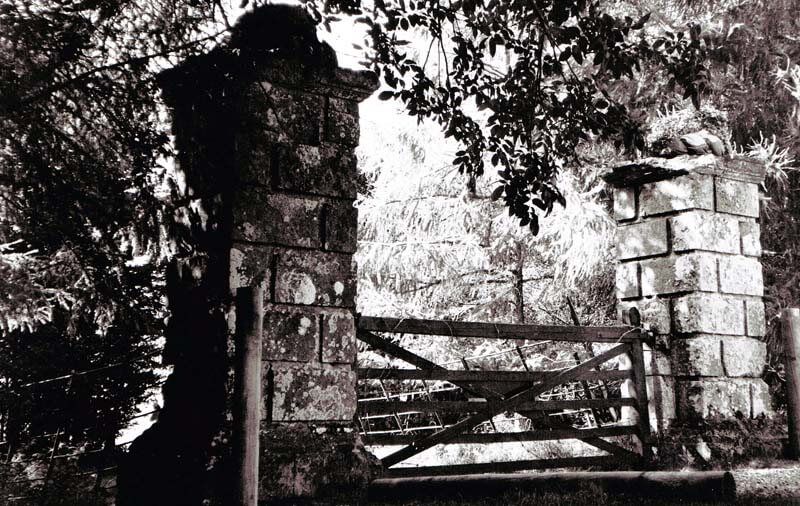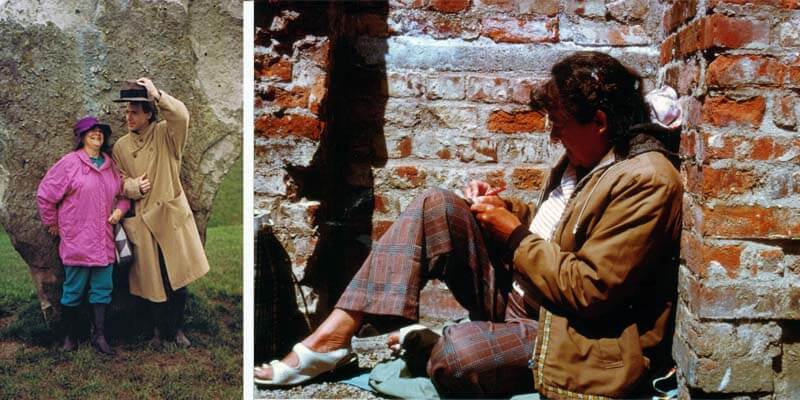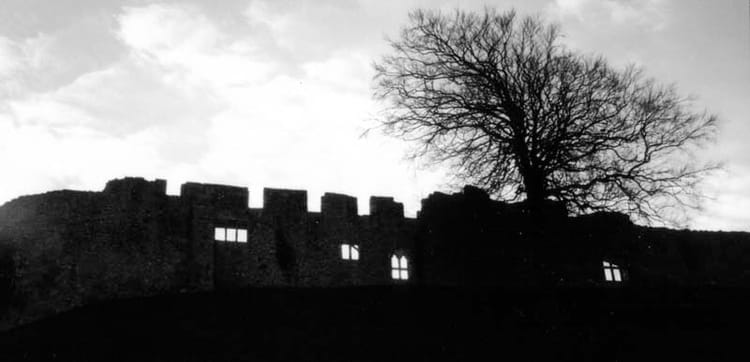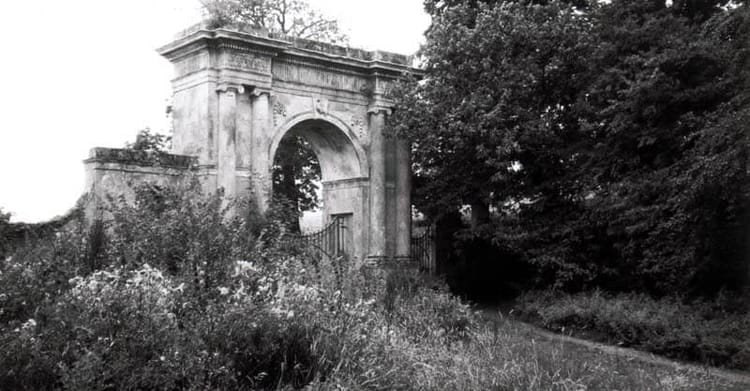Knighton Gorges House. Ghosts of the Isle of Wight, with Margo Williams

The Ghost House Ghost
IN THE YEAR 1821 Knighton Gorges house was torn down stone by stone on the order of its last owner George Maurice Bisset, never to be rebuilt.
Some people believed the destruction of that house was inevitable and that George was finally doing God an overdue favour. For long ago it was the home of bad Hugh de Morville, one of the knights who took King Henry II at his angry word, and helped m.rder Archbishop Thomas Becket.
In the final years before its destruction the house was visited by Sir Henry Englefield who described it as ‘...by far the most considerable and beautiful of the ancient mansions of the island.’
The Elizabethan manor house had ‘a fine grey tint, the west end enveloped in ivy winding round tall clustered chimney stacks and a glowing yellow ancient moss-tiled roof.’
Inside, Sir Henry noted a spacious drawing room and a long gallery through the centre of the house.
During happier times George Bisset invited celebrity Georgians to come and stay at his home.

Destroy the House
Guests included famous actor and writer David Garrick and portrait artist Sir Joshua Reynolds; to meet and mingle in the company of top island people, including his neighbour the Captain of the Isle of Wight, the right honourable and noble Sir Richard Worsley M.P. accompanied by his delightful wife Lady Seymour.
One afternoon in 1781, she returned alone at the gates with bags packed ready to elope with George.
One year later, divorce proceedings listed him among her numerous lovers, the details of which were shared by the press causing fans to flutter with society gossip; splattering George and Sir Richard’s reputations with malodorous scandal.
By the winter of old age George had turned mad and bad; his bitter heart seethed when his eldest daughter announced to him she wanted to marry her clergyman cousin Fenwick.
Old George told the couple that if they went ahead and wed, they would never again set foot in his house.
They did, and so in 1821 as he lay dying he moved into his gardener’s cottage and ordered Knighton Gorges torn down until nothing was left but the gateposts and cellars, wherein George first realised Lady Worsley was his for the taking.
Even though Knighton Gorges now is gone, supernatural incidents often are reported, including sights and sounds of ghostly horse and carriage galloping through the gate.
Others claim to have heard ghostly party-revelry drifting up along the valley; and one witness actually saw the ghost house, Brigadoon-like, close enough to look through its windows before it vanished again.
The Ghost of Knighton Gorges House
At every Halloween brave island paranormalists bring maps and torches to Knighton Gorges in the hope of seeing a ghost; and no doubt he has drifted up from the lost pool and roamed among them, staring at those who wore open-toed sandals.
He came to speak to me one autumn afternoon.
I had already found a ghost in the vicinity, an admiral whose identity we later confirmed as Hugh Pigot. While arriving for one of the parties Pigot had, through reckless haste in his carriage, k.lled a child.
But it seems that was not the only tragedy to afflict Knighton Gorges, as the ghost of the lost pool remembered.
He spoke at considerable length; he had something to clear from his conscience. A convenient accident.
“…I am looking for the crystal clear water where I met the wench with bare feet,”
Said he to me that autumn afternoon.
“Her toes so pink and beautiful in the crystal waters, those toes I was to kiss so many times. Maurice is my name. How appropriate, hers was Martha. ‘M. and M.’ we carved on a tree, ‘M. and M.’ A grey cloud has been between me and my lovely place, my country estate, the delightful home I loved. ‘M. and M.’, and ‘M. and M.’ before that. Why did the wenches always have names beginning with the letter M?
Where are the clear waters, where is the stream?” he sighed. “First Mary and Maurice, then Meg, and then Martha. My wife about to bear a child, and then the delightful young woman with perfect toes.
I indulged myself in the delights she could offer with ne’er a thought for my wife. Enjoyed the company of many people and was noted for the routs and parties I gave. I enjoyed myself to the fullest, with no thought of the grave and the footsteps of death every man must play host to.
After my child was born my meetings with Martha continued. She began to expect small trinkets after I mistakenly gave her a bauble to wear around her neck.”
The ghost fell silent but I guessed more was to come. There was; his descent into darkness.
“I was giving a grand party for a famous gentleman from London," he continued. "And all the Londoners were invited with their wives, sons and daughters. During this party I walked onto the terrace to partake of the soft air when I bespied Martha peering in a window.
This was not to be tolerated. I scolded her. She was to learn to keep her place. Such impudence! My guests were not to be troubled by her. So disconcerting.
Martha respected my wishes and kept away from the house. I saw her when I wished, but no wench, however pleasing she was, would rule me. And when I invited a famous artist to stay and meet my friends I warned her I would not meet her for a sennight."
I wondered why he was sharing so much information; felt uncomfortable.
"After my second daughter was born, again the charms of Martha enticed me away from my wife, who needed my affection. When Martha’s belly became swollen I knew the affair must be ended for ever, and I informed her as we sat by the pool, which reflected our images in the sunlight.
Ne’er shall I forget that day with the wood pigeons cooing around us.
I imagined I could send her away with a few baubles. Her pleading and whining filled me with distress; as although a firm man, this creature with her limpid blue eyes and pink toes tugged at my heartstrings. As we rose to our feet she stumbled and fell backwards into the pool, striking her head on a fallen log as she did.”
Agitation tinged his tone.
“An evil spirit entered my heart and I helped her not, I strode off back to my house, whereupon I paid a visit to my wife’s bedchamber to enquire into her well-being. I stayed holding her hand for nigh on an hour.
A serving wench informed me the groom beseeched me to see him at once. The gardener had dragged Martha from the pool, having seen her floating hair. Her blue eyes closed for ever. ‘She must have been after rabbits or birds,’ the man said, ‘and fallen.’ I expressed my regrets such a thing should happen in my grounds, and enquired into who she may be.
‘Just a wench who lives a few miles hence.’
My secret was safe, and the name of Bocland ne’er sullied.
Where is the pool, where are the trees? The pool is no more, the trees with ‘M and M’ have gone, have been cut down, my house gone. I have searched, I have sought Martha, to go to her aid.
Now a feeling of release from my search. Someone knows now, and I can rest for a long time, in peace, before proceeding to the music and lights that surpass all music and lights within my house as it was.”
And then he was gone.
Identifying the Dead
What was his name? I searched back through what he had said to me: “M and M… Mary, Meg, Martha and Maurice.”
His first name was Maurice, and he spoke the surname Bocland. With this information we searched the parish records and found him.
The Dillington family owned the manor house until the last of them, tragic suicide Sir Tristram, bequeathed it to a sister; then through marriage it passed on to a wealthy nephew, the right handsome Maurice Bocland, Member of Parliament for Yarmouth during the 1730s and ‘40s.
He was appointed Mayor of Yarmouth in 1747 and 1750 and since death, took up his position as the ghost of Knighton Gorges.
Of course cursologists still believe the destruction of his house was inevitable; Maurice’s grandson, George Bisset, did God a long overdue favour.
However, archbishop-slayer Hugh de Morville was long de.d and dusted when finally that happened. So maybe the fate of Knighton Gorges house had nothing to do with de Morville’s venerable sin.
Maybe it was angry Martha, so encouraged and yet so denied its comforts who, from beyond that secret pool of love and death, teased old George into bitter madness, and so destroyed the beloved home of its ghost.
The Ghost House
But not the ghost of his home.
On strange and spooky occasion surprised passers-by have seen old Knighton Gorges house up close; banged on its front door to complain about reckless carriage-driving.
No one answers even though its opened curtains reveal rooms busy with wigged Georgian period partygoers. Next morning, the house has vanished.
Do houses become ghosts? I haven’t seen Knighton Gorges reappear, so cannot confirm. On rare occasion I and other witnesses have seen momentarily restored Lady Seymour Worsley’s Appuldurcombe House. Books in its library, tapestries on walls and roof in place.
An atmospheric photograph? Perhaps, but Appuldurcombe’s ghost is the surprising element in that 19th century historical replay.
She engages in conversation; showed me the book selected from a shelf. Told me she is content to remain in the past; doesn’t want to leave the home she loves. Exactly how she achieves this, she didn’t explain.
Ann Oglander, Nunwell’s Grey Lady ghost spoke of a vision she kept secret from her husband: “The past came upon me,” she described it.
Ann saw a ghost building, a temple, not present during her living residency, or now she added; which suggests awareness of passing time and present position.
Time doesn’t stop for the living or the dead, it seems; clocks move forward not back, minute to hour, days to centuries. That’s how the world appears, but not the way it is.
Maurice Bocland was denied a place in his ghost house’s past. The supernatural sitting tenants of Appuldurcombe House might explain the magic missing. Martha too, probably.
Love can hold the impossible together, but lack thereof keeps it apart.
Thank you for your company on this short tour of Isle of Wight mysteries and haunting. If you would like to know more about Margo Williams' investigations and other famous and forgotten personages, read this book. Now available from Amazon.




